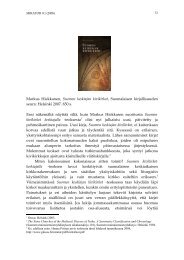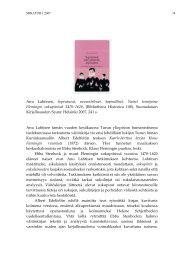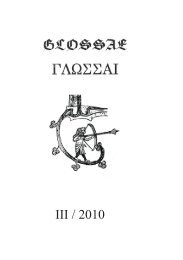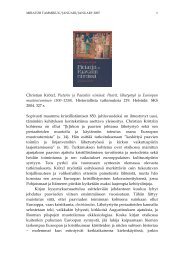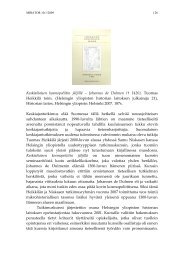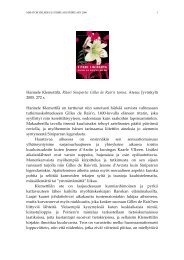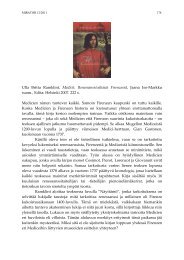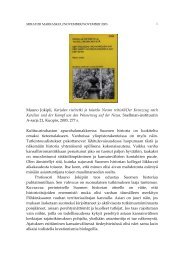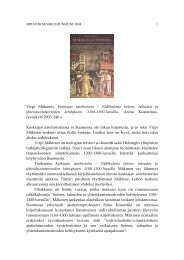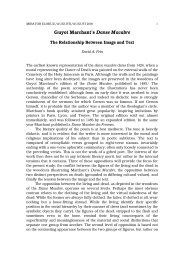Sigurðar saga fóts (The Saga of Sigurðr Foot)
Sigurðar saga fóts (The Saga of Sigurðr Foot)
Sigurðar saga fóts (The Saga of Sigurðr Foot)
You also want an ePaper? Increase the reach of your titles
YUMPU automatically turns print PDFs into web optimized ePapers that Google loves.
MIRATOR 11:1/2010 70hero King Hermann. 54 <strong>The</strong> villains build the hall for the wedding andprovide the drink so that everyone gets drunk—or, in the phrasing <strong>of</strong> AM529 4 to , “at af taufrum þeirra fellur huer madur nidur s<strong>of</strong>inn i sinu rumi”(“so that, through their magic, each person fell down asleep in theirplace”). 55 When everyone wakes up the next day, the bride is gone and thehall-floor has broken apart, leaving a coal-black pool in its place. 56 Still,although similar only in outline, this abduction <strong>of</strong> a bride from a feast bymagical means might have been an inspiration for the abduction <strong>of</strong> Signý byÁsmundr and Óláfr in <strong>Sigurðar</strong> <strong>saga</strong>. 57 It seems most likely, then, that<strong>Sigurðar</strong> <strong>saga</strong> drew material from Jarlmanns <strong>saga</strong>; in terms <strong>of</strong> dating, thiswould hint at a terminus post quem for <strong>Sigurðar</strong> <strong>saga</strong> around the midfourteenthcentury—late enough for Konráðs <strong>saga</strong> and then Jarlmanns <strong>saga</strong> tohave been composed.Dating <strong>Sigurðar</strong> <strong>saga</strong> after the beginning <strong>of</strong> the fourteenth century fitswith some other hints. In 1931 Jackson compared the <strong>saga</strong> with a broadsweep <strong>of</strong> Germanic-language texts about bridal quests and the abduction <strong>of</strong>women, but Knut Liestøl proceeded in 1933 to identify two specific sources:Hrólfs <strong>saga</strong> Gautrekssonar and Ásmundar <strong>saga</strong> kappabana. 58 A connection <strong>of</strong>some kind with Ásmundar <strong>saga</strong> is demonstrated by the genealogicalconclusion <strong>of</strong> <strong>Sigurðar</strong> <strong>saga</strong>. 59 In <strong>Sigurðar</strong> <strong>saga</strong>, Ásmundr Húnakappi has ason Hrólfr, who begets the sons Ásmundr and Hildibrandr Húnakappi (ch.9). In Ásmundar <strong>saga</strong>, King Hildibrandr <strong>of</strong> Húnaland has a son called Helgi,who in turn has a son, Hildibrandr Húnakappi, by Hildr, daughter <strong>of</strong> theking <strong>of</strong> the Swedes (ch. 2). In a subsequent marriage, she then has a son54 It may have a textual connection with the ‘master builder’ tale attested in Snorra Edda, Eyrbyggja<strong>saga</strong> and Heiðarvíga <strong>saga</strong>: Kalinke 1990, 166–79.55 Jarlmanns <strong>saga</strong>, Rydberg ed., 26; cf. ‘Jarlmanns <strong>saga</strong>’, Loth ed., 38.56 ‘Jarlmanns <strong>saga</strong>’, Loth ed., 39.57 It is perhaps suggestive that, in a passage <strong>of</strong> the shorter text edited by Rydberg which is not paralleledin Loth’s edition, the messengers who seek the hand <strong>of</strong> Hermann’s sister for their king Ermánus(Romanus in Loth’s edition), the people <strong>of</strong> Svíþjóð hin kalda are said to be ‘suo fliott-fætir, at þeir sigramio-hunda raas’ (‘so fleet-footed that they won against greyhounds in a race’; Jarlmanns <strong>saga</strong>, Rydberged., ch. 9, 11). This recalls <strong>Sigurðr</strong>’s own fleet-footedness and if it existed in a version known to theauthor <strong>of</strong> <strong>Sigurðar</strong> <strong>saga</strong>, it might have encouraged the adoption <strong>of</strong> the portrayal <strong>of</strong> Gunnar’s athleticismfrom Njáls <strong>saga</strong>.58 ‘Det litterære grunnlaget’; cf. Kalinke 1990, 197–98; Sävborg, <strong>Saga</strong>n om kärleken, 592. Liestølidentified numerous other parallels for specific aspects <strong>of</strong> the <strong>saga</strong>, particularly the characters’ names, buthe <strong>of</strong>fered, and I have found, no strong evidence for direct influence <strong>of</strong> these on <strong>Sigurðar</strong> <strong>saga</strong>.59 Fornaldarsögur norðurlanda, Guðni Jónsson and Bjarni Vilhjálmsson eds., 3 vols, Bókaútgáfan Forni:Reykjavík 1943–1944, ii 287–308; I am not aware <strong>of</strong> an English translation, but a German translation isavailable: ‘Die <strong>Saga</strong> von Asmund Kappabani’, in Ulrike Strerath-Bolz ed. and trans. IsländischeVorzeit<strong>saga</strong>s, Band I: Die <strong>Saga</strong> von Asmund Kappabani, Die <strong>Saga</strong> von den Völsungen, Die <strong>Saga</strong> vonRagnar Lodbrok, Die <strong>Saga</strong> von König Half und seinen Männern, Die <strong>Saga</strong> von Örvar-Odd, Die <strong>Saga</strong> vonAn Bogsveigir, Diederichs: Munich 1997, 17–35.



